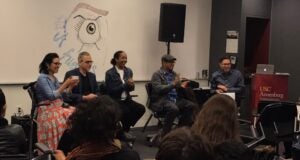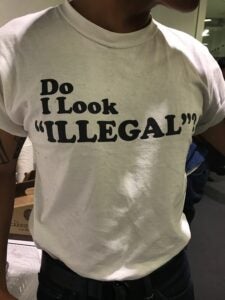
Popular Music Project & CSII event recap: The Arts of Opposition
Thank you to all who attended The Arts of Opposition on April 24th, 2017. CSII would like to thank the many people who came together to make this event possible: Professor Josh Kun of the Popular Music Project, the staff at the USC Annenberg’s Norman Lear Center, Cambalache, Los Jornaleros del Norte, National Day Laborer Organizing Network leaders Xochi Flores and Pablo Alvarado, Naima Keith from the California African American Museum, CSII staff and volunteers, and all of our audience members.
Special thanks to Claudia Dayani for the video excerpt, photos, and the event recap below.
“The Arts of Opposition” Event Recap
By Claudia Dayani, USC Annenberg Class of 2018
Can music inspire change? Can a piece of art truly challenge an administration? Can art actually do… anything? These are the questions USC Professor Josh Kun brought forth, sparking a poignant conversation about the role of art in the age of President Donald Trump- an era of unprecedented political and societal divisiveness.
“The Arts of Opposition: Art and Social Change in the Age of Trump” was held on April 24, 2017 by the Popular Music Project at USC Annenberg’s Norman Lear Center and the USC Dornsife Center for the Study of Immigrant Integration (CSII) to discuss the very question of whether artistic expression can be evocative enough to accomplish social change.
Josh Kun– a USC Annenberg professor whose work examines the cross sections between music and politics in culture–served as the event moderator which featured performances by the bands Cambalache and Los Jornaleros del Norte, a band comprised primarily of day laborers, followed by a panel discussion by musicians, activists, curators and educators.
The panel included Xochi Flores, veteran in the Chicano art and music scene, band member of Cambalache and associate director of the National Day Laborer Organizing Network (NDLON); Pablo Alvarado, band member of Los Jornaleros Del Norte and NDLON executive director ; Naima Keith, curator of the California African American Museum; and Manuel Pastor, Professor of Sociology and American Studies & Ethnicity at USC and Director of the Center for the Study of Immigrant Integration (CSII).

While racism, xenophobia, homophobia, Islamophobia, misogyny and all other forms of bigotry existed well before the Trump administration, what hasn’t been as endemic is the new era of flagrant intolerance and fear that we’re currently living in- one that unraveled when Trump ran a xenophobic presidential campaign that constructed immigrants as dangerous criminals and when, immediately upon assuming the presidency, he issued draconian executive orders on immigration. These actions have instilled a new set of fears, anxieties, and confusion amongst vulnerable communities and their allies.
In response, artists and musicians across the country have spearheaded a wave of oppositional movements through artistic and cultural mediums. The Arts of Opposition was held to discuss these rampant intersections about whether art can truly have enough impact to shift the gravity of an opinion.
“We’ve seen an outpouring and a resurgence of art and culture that has openly responded to this new era,” said Professor Kun. “Everything from A Tribe Called Quest breaking through Trump’s border wall and announcing ‘We The People’ on live television during the Grammys, to the Museum of Modern Art in New York who re-hung all of their Muslim art in opposition of Trump’s travel ban, to the Davis Museum at Wellesley College who did the opposite and removed all of their immigrant work from their walls,” he added.
For someone who dedicates their life to music and activism, Pablo Alvarado expressed that one of the purest and most effective ways to remedy social and political injustice is through art. Alvarado said that he feels the Trump administration perpetuates “fear politics” to sway public opinion on immigrants and to encourage them to leave the country. He spoke passionately about a project called “Chant Down The Walls” organized by NDLON in which he and his bandmates from Los Jornaleros Del Norte, along with other activists, travel across the country to play songs of empowerment outside of detention centers and jails where undocumented people are detained. “Chant Down the Walls” began in protest of Obama’s aggressive deportation policies and Congress’ failure to enact comprehensive immigration reform that would provide a pathway to citizenship for long-settled undocumented migrants. The sidewalk serenades also serve another purpose: “Bringing music to alleviate this fear is so essential right now. It’s one of the most beautiful acts of love that you can think of,” Alvarado said.
From a sociological standpoint, Professor Pastor expressed that despite the obvious importance of research and data within the realm of sociology and beyond, change requires more than just gathering information. “We [researchers] don’t change the world, we work with people who change the world. We understand that our data and our research do good, but they’re never going to move anything without people organizing, without people in social movements really creating the change.”
He also said that artistic and cultural expressions that are detached from social movements will not have as distinct an impact. “I think that when art, data, and research are directly connected to social movements and community-based organizations, that’s when true change happens.” Professor Pastor referenced rapper Kendrick Lamar, known for incorporating themes of social injustices–most prominently police brutality– as a good example of effectively making noise and raising awareness through music.
As Executive Director of the California African American Museum, Naima Keith spoke about stepping into her roles as curator of an African American museum at the height of the prevalence of the Black Lives Matter movement and the start of rising tensions due to the polarizing political climate. Keith expressed how many people expected the CAAM to take a strong political stance following the election, but she revealed it was actually very difficult to do so because museums are perceived to be a place of neutrality. “People were looking for spaces to gather and to talk and discuss and debate and we had to try to figure out as a museum, how we could be a neutral space and honor the diversity within our own community,” she said. Professor Pastor chimed in on the notion of acting as a “neutral space” and said that he, too, often wrestles with this issue of “objectivity” as an educator, but that art and varied opinions can be powerful without getting too politicized, if at all. “That’s where I think arts and music and culture are important because they invite people into a value space and not just intro a political space.”
As a musician, Xochi Flores explained how the kind of music she plays with her band Cambalache, evolved from a movement of musicians, community workers, and activists to a transnational dialogue that is still growing today. “We feel like we provide insight into what’s going on- in the Son Jarocho/Chicano dialogue and also in our own neighborhoods. We talk about what we see in our neighborhoods, we talk about what we want for our children and that’s how we feel we make impact and then we share it with folks in Mexico,” she said. Flores began talking about Fandango Fronterizo, which is a celebration in which music is played and enjoyed on both sides of the border. “We put one [instrument] on the San Diego border and one in Tijuana and we smash them against the fence and we play on both sides of the border. That’s something phenomenal that we as a community have cultivated. 10 years of going to this wall that is supposedly divisive but it’s actually uniting us in many ways.”
Throughout the event, Cambalache and Los Jornaleros Del Norte took the stage to perform several songs for the audience, and collaborated together for the closing tune of the evening, “Quiero Que Mi Voz Escuchen,” which means “I wish for my voice to be heard.”
Naima Keith captured the theme of The Arts of Opposition best when she said, “There exists a power in art that is limitless.”
